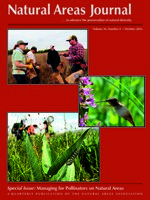Healthy plant communities of the American sagebrush steppe consist of mostly wind-pollinated shrubs and grasses interspersed with a diverse mix of mostly spring-blooming, herbaceous perennial wildflowers. Native, nonsocial bees are their common floral visitors, but their floral associations and abundances are poorly known. Extrapolating from the few available pollination studies, bees are the primary pollinators needed for seed production. Bees, therefore, will underpin the success of ambitious seeding efforts to restore native forbs to impoverished sagebrush steppe communities following vast wildfires. This study quantitatively characterized the floral guilds of 17 prevalent wildflower species of the Great Basin that are, or could be, available for restoration seed mixes. More than 3800 bees representing >170 species were sampled from >35,000 plants. Species of Osmia, Andrena, Bombus, Eucera, Halictus, and Lasioglossum bees prevailed. The most thoroughly collected floral guilds, at Balsamorhiza sagittata and Astragalus filipes, comprised 76 and 85 native bee species, respectively. Pollen-specialists dominated guilds at Lomatium dissectum, Penstemon speciosus, and several congenerics. In contrast, the two native wildflowers used most often in sagebrush steppe seeding mixes—Achillea millefolium and Linum lewisii—attracted the fewest bees, most of them unimportant in the other floral guilds. Successfully seeding more of the other wildflowers studied here would greatly improve degraded sagebrush steppe for its diverse native bee communities.
How to translate text using browser tools
1 October 2016
Floral Guilds of Bees in Sagebrush Steppe: Comparing Bee Usage of Wildflowers Available for Postfire Restoration
James H. Cane,
Byron Love
ACCESS THE FULL ARTICLE

Natural Areas Journal
Vol. 36 • No. 4
Oct 2016
Vol. 36 • No. 4
Oct 2016
Apoidea
Asteraceae
Great Basin
oligolecty
restoration




